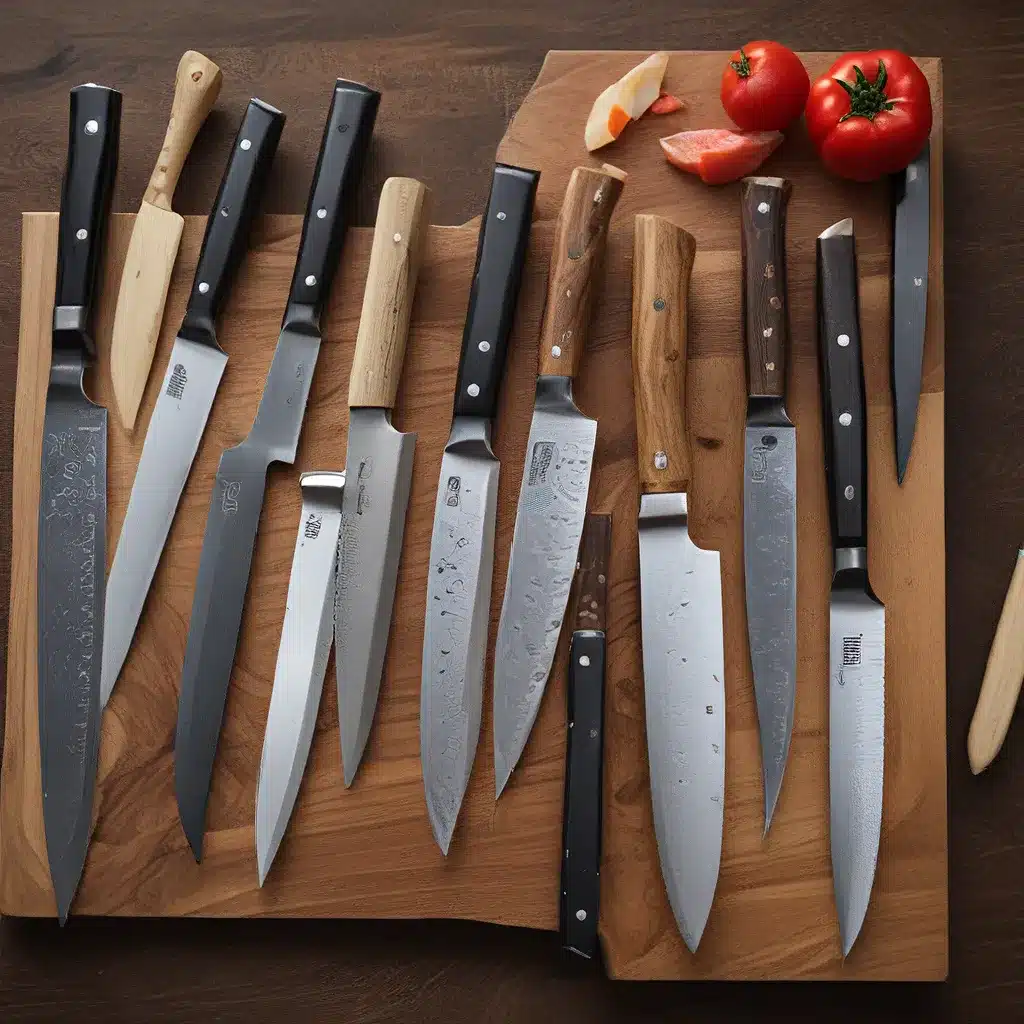
As a self-proclaimed cooking enthusiast, I’ve always been fascinated by the world of Japanese knives. These precision instruments are renowned for their exceptional sharpness, durability, and rich cultural heritage. Whether you’re a seasoned chef or a home cook looking to upgrade your kitchen arsenal, understanding the nuances of Japanese knives can be a game-changer.
The Origins of Japanese Knife-Making
The roots of Japanese knife-making can be traced back to the design and forging of the legendary samurai swords, or katanas. In feudal Japan, the art of swordsmithing held immense significance, as the sword symbolized the social standing, authority, and honor of the samurai class. These respected artisans, known as tosho, developed the techniques of steel extraction and blade forging that form the basis of modern Japanese knives.
Even today, the manufacture of Japanese blades and handles is still mainly done by hand, allowing for meticulous shaping of the cutting edge and a perfect balance between blade and handle. The most famous centers of the blacksmiths’ craft are Seki, Echizen, and Tsubame-Sanjo, where skilled craftspeople continue to hone their skills and pass down their knowledge through generations.
Navigating the Diverse World of Japanese Knives
Japanese knives come in a wide variety of shapes, designs, and materials, each serving a specific purpose in the kitchen. From the versatile Santoku to the specialized Usuba and Yanagiba, the array of options can be overwhelming for the uninitiated. However, with a little bit of guidance, you can find the perfect knife to suit your culinary needs and aesthetic preferences.
Santoku: The All-Rounder
If your culinary repertoire includes a diverse range of ingredients, the Santoku knife is an excellent choice. Its length and shape make it easy to maneuver, making it suitable for both new Japanese knife wielders and professional chefs alike. The Santoku excels at slicing, chopping, and dicing a variety of foods, from vegetables to meats and fish.
Bunka: The Versatile Workhorse
The Bunka knife is a medium-sized blade with a wide profile and a distinctive kiritsuke tip, which pays homage to the traditional tanto blades. This unique shape allows for a wide range of cutting techniques, making the Bunka a versatile tool in the kitchen. The wide blade with a slight curve in the belly is ideal for chopping, while the K-tip provides an excellent visual overview of the cutting surface and the food being prepared.
Gyuto: The Japanese Chef’s Knife
The Gyuto is the Japanese version of the Western chef’s knife. The main distinction is the thinner and lighter blade, which allows for effortless handling and precision. If you’re looking for a knife that can tackle a wide range of tasks in the kitchen, the Gyuto is an excellent choice. Its longer blade also excels at cutting larger cuts of meat and fish. For beginners, a Gyuto length between 180mm and 210mm is recommended, while more experienced cooks may prefer the 240mm length for optimal all-round performance.
The Science Behind the Sharpness
Japanese knives are renowned for their exceptional sharpness and durability, which can be attributed to the high-quality steel used in their construction. Blacksmiths often use Japanese steels such as VG-10, ZDP-189, Aogami, and Shirogami, which are known for their high hardness, edge retention, and ease of sharpening.
These blades are often made up of two or more different layers of steel, with a core of very hard, high-carbon steel clad with layers of softer, often stainless steel. This unique lamination process results in a striking damascus pattern that not only looks beautiful but also contributes to the knife’s strength and precision.
The Art of Blade Geometry
The geometry of Japanese knives is another key factor that sets them apart. Chefs can choose between single-bevel and double-bevel blades, each with its own advantages. Single-bevel knives, such as the Usuba, Deba, and Yanagiba, are specialized for specific cutting tasks and are designed for either left-handed or right-handed users. These blades have a thinner cutting edge and a stronger, more precise blade.
Double-bevel knives, on the other hand, are more versatile and suitable for a wider range of kitchen tasks, from chopping vegetables to cutting meat. These knives can be used by both left-handed and right-handed users, making them a popular choice for home cooks and professional chefs alike.
Preserving Flavor and Texture
The fine sharpness of Japanese blades is not just a matter of aesthetics; it also plays a crucial role in preserving the natural flavor and texture of ingredients. By minimizing damage to the cell membranes of food, Japanese knives allow the true essence of seasonal, local produce to shine through – a principle that is central to the concept of shun in Japanese cuisine.
Caring for Your Japanese Knife
While the exceptional sharpness and performance of Japanese knives make them a coveted tool in the kitchen, they also require a little extra care and attention. A simple rule of thumb is to avoid using them for heavy-duty tasks, such as cutting through bones, coconuts, or opening bottles. Proper use and regular maintenance are key to ensuring your Japanese knife remains a trusty companion for years to come.
Discovering Your Ideal Japanese Knife
With so many options available, it can be daunting to choose the right Japanese knife for your needs. Factors like the type of cuisine you prepare, your cutting techniques, and even your personal preferences all play a role in finding the perfect blade. Hermanknives.net offers a comprehensive selection of Japanese knives, along with helpful resources to guide you through the selection process.
Remember, the experience of cooking with a Japanese knife is more than just a functional task – it’s an art that blends tradition with modern technology, allowing you to unleash your culinary creativity and elevate your dishes to new heights. So, embark on your Japanese knife-owning journey and discover the transformative power of these remarkable kitchen tools.


